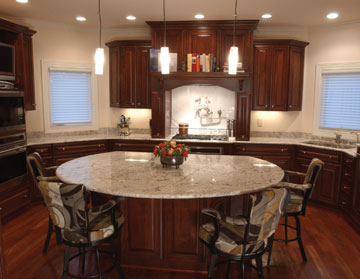A-PLUS UPGRADES
By Donna Andrews Russell
Time was when the only thing that seemed to matter to appliance shoppers was price. Claims of “We will not be undersold” and “The lowest prices in town” had customers beating paths to showroom doors.
Today, while price remains a factor in the buying decision, it’s no longer the main consideration. Americans are replacing dated kitchen and laundry appliances with bigger, sleeker, faster, smarter, more expensive models at record rates. Over the past decade, the Association of Home Appliance Manufacturers reports, there’s been a 59 percent increase in U.S. appliance shipments.
Even more significant is the growth in premium and ultra-premium appliance sales. Conspicuous consumption has moved from the garage to the kitchen, despite the fact that the National Restaurant Association reports Americans now sp/files/storyimages/half of every food dollar dining out. It’s not uncommon, says the Tr/files/storyimages/Companies of Kentucky’s Sheila Depp, for homeowners to plunk down $10,000-$15,000 on a new appliance package.
Manufacturers have responded to the luxury-appliance boom by expanding their offerings and adding more options — a strategy eerily reminiscent of the automotive industry. In fact, appliance dealers often compare their merchandise to cars. Bonnycastle Appliance & TV’s Paul Kincer refers to Whirlpool, Maytag and GE as “the Fords and Chevys” of the industry. “Brands such as Bosch are more comparable to Jaguars,” he says.
A specialist in high-end, pro-style appliances, Keith Fetzer of Fetzer for the Home divides his clientele into two categories: those who purchase performance and those who purchase prestige. “Performance-driven buyers are investing in a lifestyle,” he says. “They’re typically people who love to cook and entertain. They want to be able to prepare restaurant-quality food at home. For prestige purchasers, having a Sub-Zero refrigerator and a Wolf range in the kitchen is like having a BMW in the driveway. “
 |  |
|---|---|
This deluxe kitchen includes a Wolf five-burner cooktop and oven, another Wolf oven with microwave, White Springs granite countertops, stained solid cherry cabinetry and a Brazilian cherry floor. | A “smart” wine chiller from Sub-Zero. |
For homes priced at $750,000 and up, luxury appliances are a must simply for resale value, says Depp. However, she also sells a fair number to homeowners who are remodeling their kitchens — typically couples in their 50s “who are approaching retirement age and have the time and the money to entertain.”
The need for new appliances in itself is the impetus for many kitchen remodels, according to a research report issued last October by the NPD Group, a Houston-based market research firm. A survey of 5,000 homeowners found that malfunctioning appliances were the inspiration for more than a third of all kitchen remodeling projects in the U.S. last year.
If you’re in the market for a new cooktop or other household equipment, here’s what you should know before you start shopping.
ENERGY EFFICIENCY
In some parts of the country, power companies offer financial incentives to consumers who purchase energy-saving products the Environmental Protection Agency (EPA) calls Energy Star appliances. That’s not yet the case in the Louisville area, but the EPA estimates that replacing dated appliances will still result in substantial savings on your utility bills.
Outside of heating and cooling, your home’s biggest energy hog is most likely the refrigerator. Those manufactured before 1993 cost $100-$200 a year to operate, compared to about $40 for today’s Energy Star refrigerators. If you’re planning to replace your refrigerator and put the old one in the garage or basement, you may be better off purchasing two new ones.
Replacing your old top-loading washing machine can take a hefty chunk out of your annual utility bills, says the EPA. Energy Star washers use 50 percent less energy and only 18-25 gallons of water per load, compared to 40 for regular washing machines, so you’ll save on your water bill as well. “The new front-loading washing machines will eventually pay for themselves,” says Whirlpool Corp. account manager Ken Faulkner.
TIME SAVERS
On average, American women sp/files/storyimages/less than 10 hours a week on meal preparation and cleanup (compared to 44 at the turn of the 20th century). Yet appliance makers are constantly developing new ways to help us sp/files/storyimages/even less time slaving over the stove. High on the list are convection ovens, which cook about 25 percent faster than conventional electric ovens and eliminate the central “sweet spot.” Busy cooks can put the entire oven to use — a big plus during the annual holiday baking crunch.
Multi-mode convection ovens — “convection plus” as Kincer puts it — offer several different cooking options, from standard and convection bake, roast and broil to dehydration modes for drying fruits, vegetables and herbs. For those reluctant to make the convection conversion, many manufacturers are including “brains” that can take a recipe and automatically set the best cooking mode, correct temperature and cooking time.
How would you like to be able to take a chicken breast from raw to table-ready in just eight minutes? Speed cooking systems, such as GE’s Advantium oven, combine the speed of a microwave with the browning and crisping capabilities of a regular oven. While GE was first in the market with speed cooking, other manufacturers such as Whirlpool, Kitchen Aid, Miele and Electrolux have followed suit and are offering new features such as non-stick interiors and family-friendly programming.
In the laundry room, switching from a top-loading washer to a front-loader saves not only on utilities but on time. Large capacity machines, such as the Whirlpool Duet, can wash 22 full-size towels in a single load without ever getting out of balance. And super-fast spin cycles mean clothes dry much faster — often in less time than it takes to wash them.
Tired of waiting to go to bed after a big family gathering or party because you have to finish the dishes? For many households, the solution to the dishwasher dilemma is simple: Buy two and use one as an auxiliary for big stockpots or for when you entertain.
CONVENIENCE
Ever-increasing sales of drawer-style appliances are all about convenience. You can now purchase drawers that keep cooked foods warm, cold foods cold and even wash the dishes.
Warming drawers, for example, are a boon to families with conflicting schedules, because they can keep dinner fresh for hours, allowing everyone to eat a hot meal. Refrigerator drawers stocked with juice boxes, water and snacks keep kids out of the food prep area while Mom or Dad is cooking. Perfect for singles and empty-nesters, dish drawers are sized for smaller loads and are great in butler’s pantries and bars for after-party cleanups.
STYLE
Back in the mid-1980s, the manufacturer Sub-Zero set a precedent by hiring designer Jerome Caruso to redesign its line of built-in refrigerators. Since then, he’s worked his magic not only on refrigerators, but also on wine chillers and Wolf stoves and ovens.
Caruso’s influence has since swept the appliance industry. For the past few years, stainless steel has been the finish of choice in American kitchens and is available even in moderately priced lines. Other high-style features that trace their origin to Caruso include integrated controls on dishwashers, ranges, cooktops and wall ovens; cabinet-depth refrigerators that look built-in; and appliance suites with matching handles for better flow.
While the stainless rage continues unabated, some manufacturers are offering alternatives to those who want a warmer look in their kitchens. Jenn-Air, for example, introduced black and white floating-glass appliances last year and Wolf is offering two new finishes: matte platinum and carbon, an acid–extruded steel with a blackened appearance, both designed to cut down on fingerprints. Also coming back into style, especially in traditional kitchens, are integrated appliances, disguised by cabinet panels.
And if you’re one of those consumers who like to be on fashion’s leading edge, you should definitely consider a refrigerator with French doors and bottom-mounted freezer, a single-serve coffeemaker or a wine chiller. All three are on the hot list right now.


